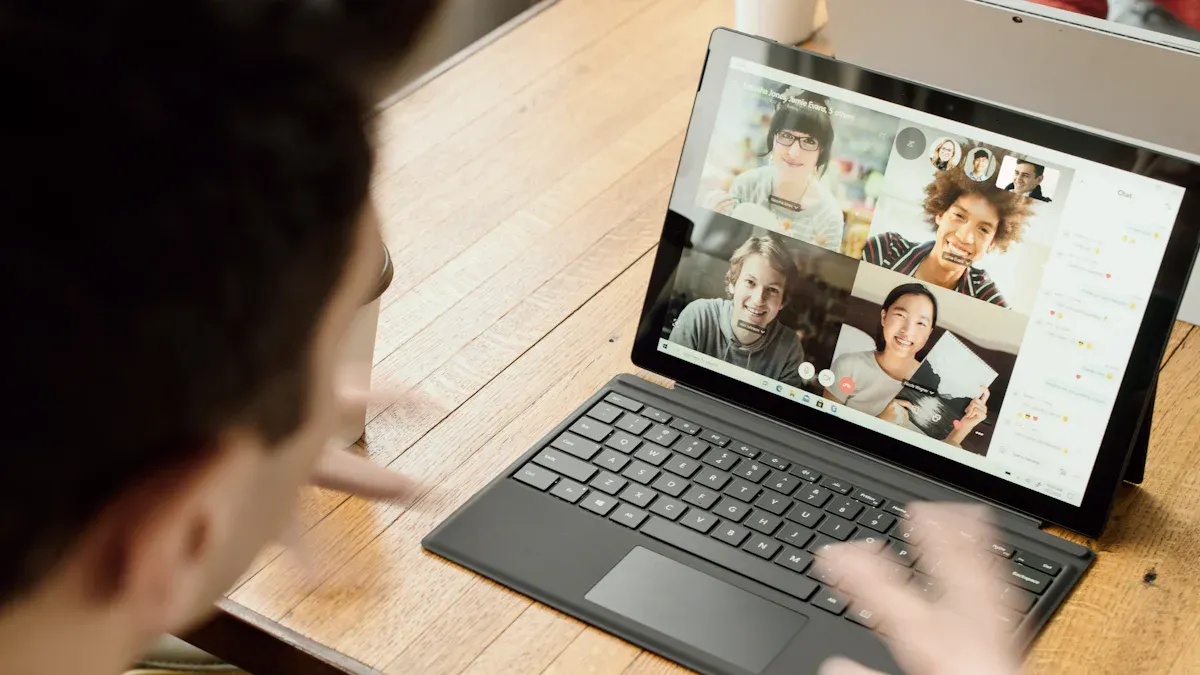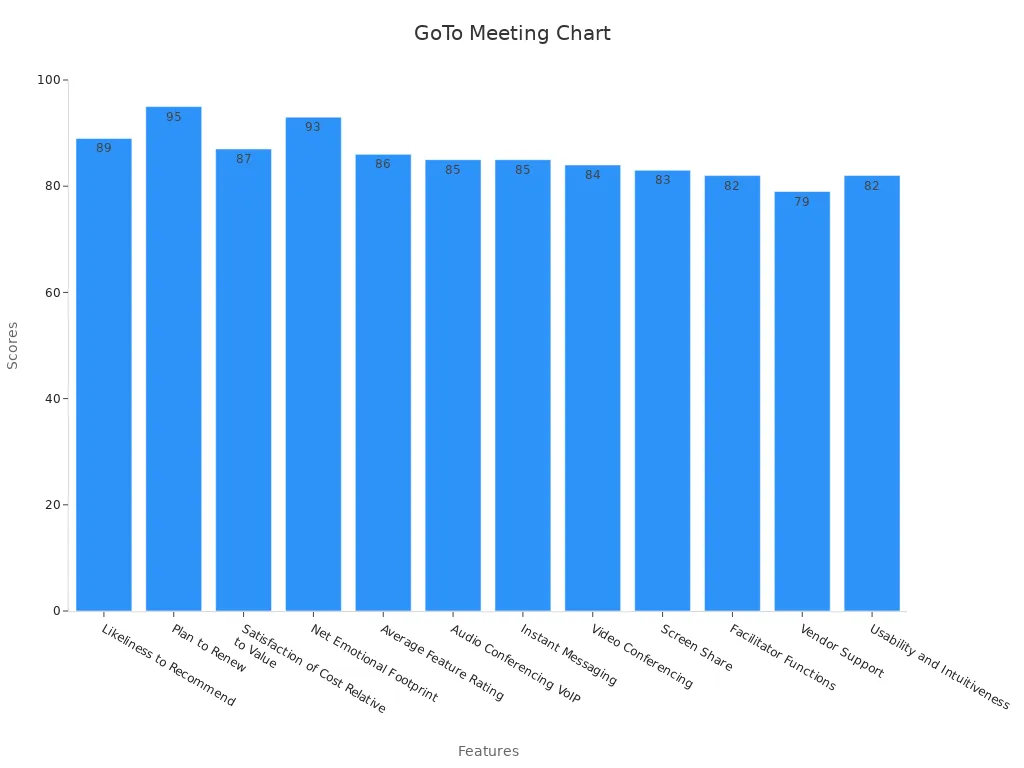
Imagine trying to work with your team, study with classmates, or catch up with family without video calls. In 2025, video conferencing solutions have become essential for staying connected. The market is booming, expected to jump from $12.5 billion in 2024 to $29.5 billion by 2033, growing at 10.1% annually. Why? Over half of U.S. remote-capable employees work hybrid or fully remote, and the right software makes it all possible. Tools like Zoom or Microsoft Teams can boost communication, saving companies $33,000 on travel while increasing productivity by up to 25%. Picking the right platform isn’t just a choice—it’s how you stay ahead.
Pick video tools that are simple to use. Easy designs let everyone join meetings without trouble.
Find platforms that grow with your needs. Tools like Zoom and Microsoft Teams work for small chats or big webinars easily.
Focus on safety features. Choose tools with strong encryption and privacy rules to keep your data safe.
When choosing video conferencing solutions, ease of use should be at the top of your list. A clean, intuitive interface ensures that everyone, from tech-savvy users to beginners, can join meetings without frustration. Features like one-click meeting links and simple navigation make a big difference. High-quality audio and video also play a role here, as they keep communication smooth and engaging. After all, no one wants to waste time figuring out how to unmute themselves or share their screen.
Whether you're hosting a small team meeting or a company-wide webinar, scalability matters. Platforms like Zoom and Microsoft Teams have proven they can handle everything from one-on-one calls to sessions with hundreds of participants. Testing shows that even with multiple users on the same network, these tools maintain stable connections and high-quality performance. This flexibility ensures your video conferencing solution grows with your needs.
In 2025, security is non-negotiable. Most platforms now offer encryption by default, with some, like Zoom and Webex, providing end-to-end encryption for added protection. Compliance with regulations like GDPR ensures your data stays private. As one study noted, video conferencing tools are often safer than many apps or websites. You can feel confident sharing sensitive information during your calls.
The best video conferencing solutions don’t just work alone—they integrate seamlessly with other productivity tools. For example, Zoom connects with Slack for easy meeting scheduling, while Google Meet syncs with Google Calendar to embed meeting details automatically. These integrations save time and streamline workflows, making your day more efficient.
Cost is always a factor, but value matters more. Many platforms offer free plans with basic features, while paid tiers unlock advanced options like recording and transcription. For businesses, these tools can save thousands by reducing travel costs and improving productivity. For example, telehealth services using video conferencing have cut emergency visits by 7%, showing how these solutions deliver real-world savings.

Zoom remains a favorite among video conferencing solutions, and it’s easy to see why. With over 192,600 enterprise customers, it’s a go-to choice for businesses of all sizes. Its user-friendly interface makes scheduling and joining meetings a breeze. Zoom’s financial performance also reflects its reliability, with a net free cash flow of $416 million last quarter—a 25% jump from the previous year. Whether you’re hosting a quick team huddle or a large-scale webinar, Zoom’s scalability ensures smooth communication. Analysts are optimistic about its future, with a target share price of $97, showing confidence in its stability.
Microsoft Teams is more than just a video conferencing tool; it’s a complete collaboration platform. It integrates seamlessly with Microsoft 365, letting you share files, schedule meetings, and chat—all in one place. Teams shines in its ability to support large organizations, offering features like breakout rooms and live event hosting. Its security measures, including multi-factor authentication, ensure your data stays safe. If your team already uses Microsoft products, Teams is a natural fit to streamline workflows.
Google Meet stands out for its simplicity and integration with the Google ecosystem. You can schedule meetings directly from Google Calendar and join with a single click—no extra software needed. Users praise its adaptive quality adjustments, which keep meetings stable even in areas with weak signals. Built on Google’s cloud infrastructure, Meet prioritizes smooth communication and security. Meetings are encrypted, and participant controls help you manage who joins. If you value ease of use and reliability, Google Meet is a solid choice.
Cisco Webex is a powerhouse for secure and professional video conferencing. Its robust security features include network access control, infrastructure monitoring, and encryption for all data. Webex is also ISO-certified and SOC 2 Type II audited, making it ideal for industries with strict compliance requirements. The Cisco Product Security Incident Response Team (PSIRT) ensures vulnerabilities are addressed promptly. If security is your top priority, Webex delivers peace of mind.
Security Feature | Description |
|---|---|
Network Access Control | Firewalls and Intrusion Detection System protect the Webex network perimeter. |
Infrastructure Monitoring | Regular scans and hardening of infrastructure components. |
Cryptographic Controls | Encryption for all data, including passwords. |
Compliance Certifications | ISO 27001, 27017, 27018, and 27701 certified; SOC 2 Type II audited. |
RingCentral Video combines simplicity with powerful features. It integrates with popular tools like Slack and Microsoft Teams, making it easy to schedule and manage meetings. Its HD video and audio quality ensure clear communication, even during long calls. RingCentral also offers advanced analytics, helping businesses track meeting performance and participant engagement. If you’re looking for a solution that balances ease of use with advanced functionality, RingCentral Video is worth considering.
GoTo Meeting is a reliable option for businesses seeking a straightforward video conferencing tool. It scores high in user satisfaction, with 95% of users planning to renew their subscriptions. Features like screen sharing, instant messaging, and VoIP audio conferencing make it versatile for various use cases. Its intuitive interface ensures you can start meetings quickly without a steep learning curve.

If you want a tool that delivers value for money and consistent performance, GoTo Meeting is a strong contender.

When comparing video conferencing solutions, features play a crucial role in determining the right fit for your needs. Platforms like Zoom and Microsoft Teams excel in offering interactive tools such as breakout rooms, live transcription, and screen sharing. Google Meet keeps things simple with real-time captions and seamless integration with Google Workspace. Meanwhile, Cisco Webex stands out with AI-powered features and robust security measures. Here's a quick look at how some platforms stack up:
Feature | Zoom | Microsoft Teams | Google Meet | Cisco Webex | BlueJeans by Verizon |
|---|---|---|---|---|---|
Analytics | Usage insights | Engagement reporting | Limited | Interactive visualizations | Comprehensive dashboard |
Meeting Room Capabilities | One-touch starts | Breakout rooms | Basic | HD video, screen sharing | Fully connected spaces |
Security | Locked meetings, encryption | High-level compliance | Encrypted meetings | Enterprise-grade security | Passcodes, encryption |
Integrations | 1,500+ apps | 250+ apps | Google Workspace | Extensive App Hub | App network for Pro plans |
Pricing varies widely across platforms, so it's essential to find one that fits your budget. For instance, GoTo Meeting starts at $12 per user per month, while Google Meet offers a free version with basic features and paid plans starting at $6 per user. Cisco Webex provides a free plan but charges $15 per user for advanced options. Here's a breakdown:
Software | Best For | Price Range |
|---|---|---|
GoTo Meeting | Quick team meetings | Starts at $12/month |
Google Meet | Small teams | Free to $6/month |
Cisco Webex | Large organizations | Free to $15/month |
BlueJeans | Interactive events | Starts at $12.49/month |
ClickMeeting | Remote training | Starts at $25/month |
Ease of use can make or break your experience with video conferencing solutions. Zoom is known for its intuitive interface and reliable performance, even on low bandwidth. Microsoft Teams offers powerful collaboration tools but may feel overwhelming for new users. Google Meet keeps things simple, making it ideal for beginners.
Zoom: User-friendly, versatile features, and mobile compatibility.
Microsoft Teams: Great for collaboration but resource-intensive.
Google Meet: Simple and efficient, perfect for quick meetings.
Security is a top priority in 2025. Platforms like Cisco Webex and Zoom offer end-to-end encryption and advanced security protocols. Webex also provides compliance certifications like ISO 27001, ensuring your data stays safe. Additionally, many platforms anonymize user data and provide transparent privacy policies to build trust.
Key Security Features:
End-to-end encryption for secure communication.
Compliance with global privacy regulations.
Different platforms shine in specific scenarios. For example, Zoom is perfect for webinars and large meetings, while Google Meet works well for small teams. Cisco Webex is ideal for industries requiring high security, such as healthcare and government.
Industry | Use Case Description |
|---|---|
Healthcare | |
Education | Virtual classrooms and interactive learning sessions. |
Business | Seamless communication for remote work and presentations. |
Government | Secure communication between departments. |
Entertainment | Live streaming and virtual events. |
If you’re running a small business, you need a video conferencing tool that’s affordable, easy to use, and scalable as your team grows. Zoom and Google Meet are excellent choices here.
Zoom: Its free plan supports up to 100 participants for 40-minute meetings, which is perfect for small teams. Paid plans start at $14.99 per month, offering features like meeting recording and breakout rooms.
Google Meet: This tool integrates seamlessly with Google Workspace, making it ideal if you already use Gmail or Google Calendar. Its free version allows meetings up to 60 minutes, while paid plans start at just $6 per user per month.
Small businesses often operate on tight budgets, so these tools provide great value without compromising on quality. Plus, the rise of hybrid work models means you’ll benefit from tools that integrate physical and virtual meeting spaces effortlessly.
Tip: Look for platforms that offer free trials or flexible pricing tiers. This way, you can test the waters before committing to a paid plan.
For large enterprises, scalability and security are non-negotiable. You need a platform that can handle thousands of participants without breaking a sweat. Microsoft Teams and Cisco Webex are top contenders in this category.
Microsoft Teams: With its robust infrastructure, Teams supports large-scale meetings and live events. It integrates with Microsoft 365, making it a natural fit for organizations already using Office tools. Multi-factor authentication and compliance with global regulations ensure your data stays secure.
Cisco Webex: Known for its enterprise-grade security, Webex offers features like end-to-end encryption and compliance certifications (ISO 27001, SOC 2 Type II). Its scalability is unmatched, allowing you to host massive webinars or virtual conferences without quality loss.
Scalability isn’t just about adding users. It’s about ensuring the platform grows with your business, supporting larger meetings, advanced features, and enhanced security. Both Teams and Webex excel in these areas, making them ideal for multinational corporations.
Educators need tools that foster engagement and make remote learning interactive. Zoom and Google Meet shine in this space, offering features tailored for virtual classrooms.
Zoom: Its breakout rooms are perfect for group discussions, while the polling feature keeps students engaged. Zoom also offers integrations with learning management systems (LMS), making it easier to manage classes.
Google Meet: Simplicity is key for educators, and Google Meet delivers. Its real-time captions and easy scheduling through Google Calendar make it a breeze to use. Plus, it’s free for schools using Google Workspace for Education.
Virtual learning can be less engaging than face-to-face interactions, but tools like these bridge the gap. They enhance collaboration and make remote education more effective.
Note: If you’re an educator, check if your institution qualifies for free or discounted plans. Many platforms offer special pricing for schools and universities.
Not everyone has the budget for premium plans, and that’s okay. Free video conferencing platforms like Google Meet and Zoom offer plenty of features to keep you connected.
Google Meet: Free for up to 100 participants with a 60-minute time limit. It’s perfect for quick team meetings or casual catch-ups.
Zoom: The free plan supports 40-minute meetings with up to 100 participants. It’s a great option for small teams or personal use.
Cisco Webex: Offers a free plan with 50-minute meetings and up to 100 participants. It’s a solid choice if you need enterprise-grade security without the cost.
Free tools are a lifesaver for startups, freelancers, and anyone on a tight budget. They improve productivity and collaboration without requiring a financial commitment. Plus, with advancements in AI and machine learning, even free plans now offer impressive video and audio quality.
Pro Tip: If you’re unsure which platform to choose, start with a free plan. You can always upgrade later as your needs evolve.
Choosing the right video conferencing tool can transform how you connect and collaborate. Solutions like Zoom, Microsoft Teams, and Google Meet offer standout features tailored to different needs. Studies show that tools with Video Meeting Signals (VMS) improve satisfaction and learning outcomes. Explore free trials to find the perfect fit for your goals.
If you're new to video conferencing, Google Meet is a great choice. Its simple interface and one-click meeting links make it easy to use without any hassle.
Yes, you can! Tools like Zoom, Google Meet, and Cisco Webex offer free plans. They’re perfect for small teams or quick meetings without spending a dime.
Choose platforms with end-to-end encryption like Cisco Webex or Zoom. Avoid sharing meeting links publicly, and always enable password protection for added security.
Tip: Regularly update your software to protect against vulnerabilities.